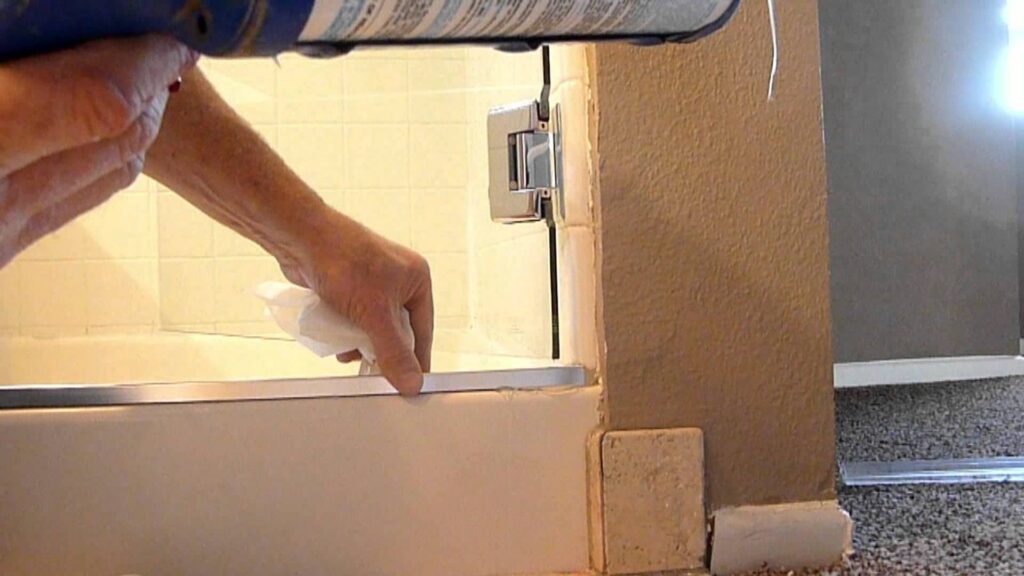One of the main functionalities of this element, or even the main one, is that it isolates the bathroom from possible splashes that we produce when showering, so knowing how to seal a shower screen is fundamental.
If you are considering it either because you have bought a new one and want to install it yourself or because you have disassembled your shower screen to clean it, the last step before enjoying this space again is to seal it correctly with silicone, have you ever done it?
Do not worry if you have to do it, it is quite simple and you only have to take into account some considerations so that the result is spectacular and you do not have to ask anyone for help, ready?
What material do I need to seal a shower screen?
First we are going to start with the things you need before getting down to work. They are not many or very expensive, but it is necessary that you take them into account so that you do not miss anything once you are already in the process.
Keep in mind that if you do not have the space already clean, you will need to remove dirt and other debris:
- Spatula
- Soap and water or another disinfectant product.
- Fiber cloth
If you already had everything prepared and you only need to waterproof the shower screen, this is what you need:
- Silicone
- Glue gun
- Plastic gloves
Before continuing and telling you the steps so that you know how to seal a shower screen, we want to tell you about the importance of choosing silicone, believe us, you will appreciate it!
The importance of silicone
Keep in mind that this is going to be the element that, in addition to our skill, will make the screen, or the shower tray, perfectly insulated. This is not only important to avoid splashing outside the bathroom, something that is very good, but it is that it prevents moisture from leaking from both our house and possibly that of the neighbors, as you can see, it is essential to make a good seal!

Because of all the problems that we can save ourselves, we recommend that, as you get down to work, you get a good silicone bottle. You will only need one, so the expense will not be very high. The recommended characteristics are: that it is specific silicone for bath and, as a plus, that it is antifungal.
This is essential due to the humidity conditions of the space and thus you will avoid having to change it too frequently or some other dislike related to these unwanted inhabitants in the shower (and in any other place).
You can also find white or transparent silicone, so this choice will depend on your shower tray and your screen. If you have the white profiles or the shower tray of this color, bet on the white silicone, if it is of any other color, better transparent.
Now that you know the tips for choosing a good silicone, it’s time for you to learn how to seal a shower screen with it, don’t you think?
How to seal a shower screen correctly?
1. Clean the surface and dry it
The first thing we have to do, if we have not done it already, is to clean the space well. We are not referring only to the profiles or the plate, but also the tiles. This step is very important because if any of the surfaces is dirty, the silicone will not adhere correctly.
If it is a silicone change, remove the remains with a spatula and apply soapy water to the surface until it is clean.
It is also a good idea to disinfect the area before putting on a new layer as this will prevent bacteria or mold from remaining that can spoil our work in a short time.

One of the essential questions on how to seal a shower screen is to rinse the surface well and also dry it properly before starting to give it a new layer. With a fiber cloth that does not leave residue, dry the entire wall, the plate and the profiles, so there is not a drop!
2. Make sure you have fixed it correctly
If you are installing a new screen or you are repositioning the one you had after a deep cleaning, make sure first of all that the profiles are well adjusted to the walls and also to the shower tray.
If this is not the case, there will be gaps that are too wide that can cause the silicone not to stick correctly or that it ends up deteriorating due to having to cover and protect too much space. We don’t have to make a mess at home!
3. How to apply silicone to seal a screen
Now, we come to the key point about how to seal a shower screen, how to apply silicone well! With our clean and dry surface, we are going to prepare the gun or cartridge. If you are going to use a gun there is not much mystery, you just have to put the cartridge inside and when you press the trigger gently the silicone will come out depending on the opening of your gun.
If you’re doing it through a cartridge, you may have to cut the cannula. The main thing: do not open a hole greater than 5 mm because otherwise we will apply more silicone than desired. It is also advisable to cut it at an angle of about 45º to make the application easier.
Once we have it prepared, we are going to apply the silicone evenly and without stopping throughout the wall or plate line that we are sealing. Why in this way? To leave no gap! If we stop and start two things can happen: that we leave gaps without filling and that when we stop and lift the silicone it continues to come out and we begin to stain the entire plate, wall or screen.
We will apply from corner to corner and, when we reach the end, we will lift the cannula and, using a piece of paper, putting it in the opening, we will avoid staining. Protecting the nozzle with the paper we go to another point to seal and start again.
4. Smooth the application
This is a simple step and one that, depending on tastes, can bring some satisfaction. With the plastic gloves on, you have to moisten the tip of your index finger in soapy water and pass it over the joint to which you have applied the silicone.
In this way we are going to achieve two things: on the one hand, that the silicone enters each small nook with the pressure of our finger, on the other hand, that the surface of the silicone is well smoothed.
When doing this, the excess silicone will overflow from the sides of our finger, but don’t worry, we… we continue with that now!
5. Clean up the remains
We will have to clean those excess remains before they dry or we will have to float more. If you have a cloth that no longer has much value, it may be your best option, but that does not release fibers. The silicone may stick to the fabric and make it difficult to remove the residue.

6. Let the silicone dry
You already know how to seal a shower screen! Now you just have to admire your work and … have some patience because you will have to let it dry. The time depends on the specifications of the silicone manufacturer but we would even recommend that you let it dry for at least 24 hours, so, after all the work, you are healthy!
Keep in mind that these tips apply to both the screen and the plate, as it is important that both are well sealed in the face of possible inconveniences.
Have you been encouraged to do it yourself? Do you want to enjoy a new bathroom? Discover our screens and shower trays at Complete Shower Seal and find the models that best suit what you need, you would already know how to seal them!
You may also like to read: Construction Certificate: Who can best ask for it?




Recent Comments